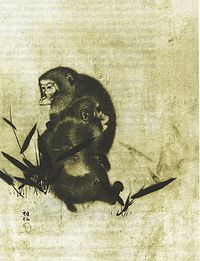25:
151:. Though there are many broad similarities between the styles within the school, these styles display key differences that separate them. Many were in fact reactions to one another, an artist or group of artists seeking to express themselves differently from those around them. Those subscribers of the Kyoto school found themselves at odds with the state sanctioned
122:
169:
dynasties in China. The two latter schools focused on the power of the artist as a lay person or scholar, as opposed to a professional. Okakura noted Kyoto school's attempts to repurpose the
Japanese tradition of copying works from other (predominantly Chinese) cultures, a technique known as
197:
or
Southern School styles. The Shijō style had an urban character and predated the Japanese and Chinese artists a century later in anticipating the need to use styles that appeal to an emergent bourgeois class.
219:
The Kyoto tradition is evidenced in the ceramic art of potters of the
Kiyomizu and Awata kilns, which specialized in enameled porcelains and pottery, respectively.
187:(四条) literally translates to 'fourth avenue.' This school, which was established by Matsumura Goshun, sought to produce a synthesis of the more realistic style of
176:. Unlike the bold and colorful style of the Kanō school or the restrained elegance of Tan'yu school, the Kyoto style favored surreal and elongated forms.
161:, predominant Japanese art historian of the late nineteenth and early twentieth centuries, traced the origins of the Kyoto school to the schools of both
269:
209:
or
Southern School, meanwhile, rebelled against the realism of Ōkyo and the Shijō artists, seeking to return to the inspiration and style of
42:
390:
329:
108:
411:
89:
365:
61:
46:
68:
75:
35:
57:
233:
357:
386:
361:
325:
302:
265:
158:
144:
82:
349:
294:
210:
213:
352:
Art and
Revolution in Modern China: The Lingnan (Cantonese) School of Painting, 1906-1951
285:
Kameda-Madar, Kazuko (2014-09-01). "Copying and Theory in Edo-Period Japan (1615–1868)".
350:
228:
152:
405:
188:
180:
166:
162:
238:
193:
24:
199:
148:
129:
306:
298:
179:
One of the more prominent schools under the Kyoto school umbrella was the
121:
172:
183:, named after the street where many of the artists had their studios.
120:
322:
The Life and
Afterlives of Hanabusa Itchō, Artist-Rebel of Edo
264:. Mineola, New York: Dover Publications, Inc. pp. 87–89.
18:
202:
was one of the more prominent painters in the Shijō school.
356:. Berkeley, CA: University of California Press. pp.
155:, thus contributing to the vague nature of the former.
385:. North Clarendon, VT: Tuttle Publishing. p. 128.
143:) was a collection of several styles and schools of
383:
The
Ceramic Art of Japan: A Handbook for Collectors
49:. Unsourced material may be challenged and removed.
16:Styles of Japanese painting of the late Edo period
262:Ideals of the East: The Spirit of Japanese Art
8:
109:Learn how and when to remove this message
249:
7:
343:
341:
255:
253:
47:adding citations to reliable sources
14:
381:Munsterberg, Hugo (2010-10-10).
23:
34:needs additional citations for
1:
324:. Leiden: BRILL. p. 21.
348:Croizier, Ralph C. (1988).
428:
320:Wattles, Miriam (2013).
260:Okakura, Kakuzo (2005).
412:Schools of Japanese art
299:10.1111/1467-8365.12111
58:"Kyoto school" art
132:
124:
43:improve this article
133:
271:978-0-486-44024-8
191:with that of the
145:Japanese painting
119:
118:
111:
93:
419:
397:
396:
378:
372:
371:
355:
345:
336:
335:
317:
311:
310:
282:
276:
275:
257:
114:
107:
103:
100:
94:
92:
51:
27:
19:
427:
426:
422:
421:
420:
418:
417:
416:
402:
401:
400:
393:
380:
379:
375:
368:
347:
346:
339:
332:
319:
318:
314:
284:
283:
279:
272:
259:
258:
251:
247:
225:
214:Southern School
115:
104:
98:
95:
52:
50:
40:
28:
17:
12:
11:
5:
425:
423:
415:
414:
404:
403:
399:
398:
391:
373:
366:
337:
330:
312:
293:(4): 708–727.
277:
270:
248:
246:
243:
242:
241:
236:
231:
224:
221:
159:Kakuzo Okakura
117:
116:
31:
29:
22:
15:
13:
10:
9:
6:
4:
3:
2:
424:
413:
410:
409:
407:
394:
392:9781462913091
388:
384:
377:
374:
369:
363:
359:
354:
353:
344:
342:
338:
333:
331:9789004202856
327:
323:
316:
313:
308:
304:
300:
296:
292:
288:
281:
278:
273:
267:
263:
256:
254:
250:
244:
240:
237:
235:
232:
230:
227:
226:
222:
220:
217:
215:
212:
208:
203:
201:
196:
195:
190:
189:Maruyama Ōkyo
186:
182:
177:
175:
174:
168:
164:
160:
156:
154:
150:
146:
142:
138:
131:
127:
123:
113:
110:
102:
99:November 2008
91:
88:
84:
81:
77:
74:
70:
67:
63:
60: –
59:
55:
54:Find sources:
48:
44:
38:
37:
32:This article
30:
26:
21:
20:
382:
376:
351:
321:
315:
290:
286:
280:
261:
218:
206:
204:
192:
184:
181:Shijō school
178:
171:
157:
147:of the late
140:
137:Kyoto school
136:
134:
125:
105:
96:
86:
79:
72:
65:
53:
41:Please help
36:verification
33:
287:Art History
239:Tosa school
234:Hara school
229:Kanō school
163:Manchu-shin
153:Kanō school
367:0520059093
245:References
200:Mori Sosen
149:Edo period
130:Mori Sosen
69:newspapers
307:1467-8365
406:Category
223:See also
211:China's
173:utsushi
126:Monkeys
83:scholar
389:
364:
328:
305:
268:
85:
78:
71:
64:
56:
207:nanga
194:nanga
185:Shijō
139:(京都派
90:JSTOR
76:books
387:ISBN
362:ISBN
326:ISBN
303:ISSN
266:ISBN
205:The
167:Ming
165:and
135:The
62:news
295:doi
141:-ha
128:by
45:by
408::
360:.
358:35
340:^
301:.
291:37
289:.
252:^
216:.
395:.
370:.
334:.
309:.
297::
274:.
112:)
106:(
101:)
97:(
87:·
80:·
73:·
66:·
39:.
Text is available under the Creative Commons Attribution-ShareAlike License. Additional terms may apply.
